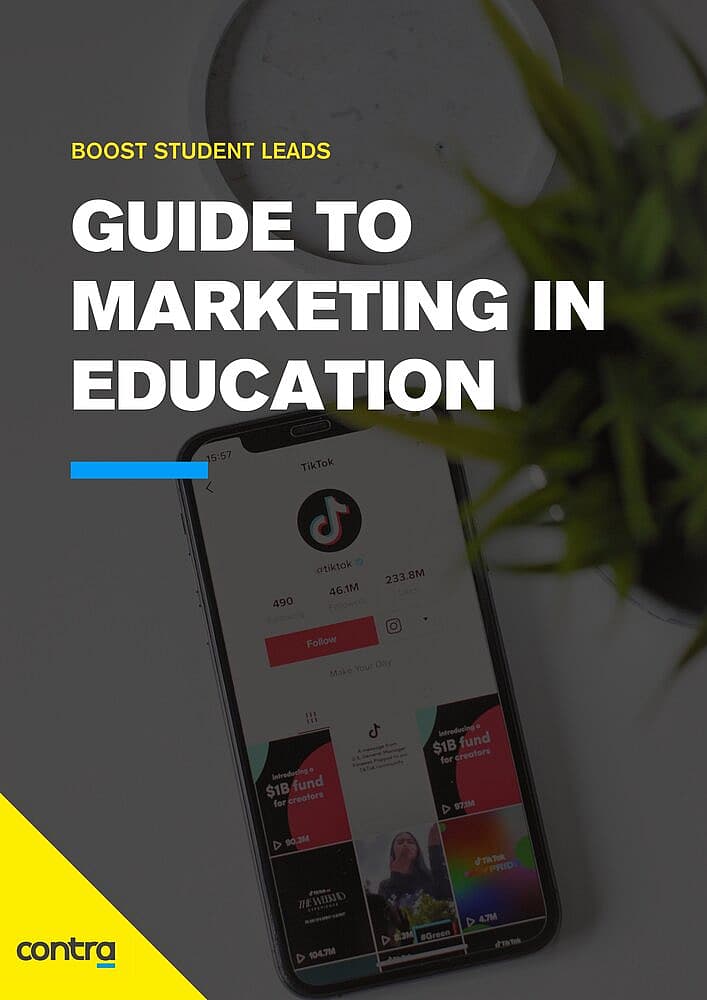Boosting student leads through marketing automation
02.05.2021
Whether you’re a time-poor marketing department or a large team running a slick operation, marketing automation is an essential tool to boost student leads.
Successful automation should do the heavy lifting of your student acquisition and community building efforts but, as alluded to a lot in this series, careful planning and implementation are essential. So let’s look at the different types of marketing automation and what they can help with:
1. Email Marketing Automation
As mentioned earlier in the series email is a powerful tool for reaching prospective students and creating community with existing ones. With 76% of university students preferring to receive communication via email, this is an area that needs constant attention
Email automation is typically triggered by time or action. Time based emails can include different stages of a student’s relationship with you (e.g. on their first day at college, during exam season or on graduation). You most likely have received these sorts of emails from your favourite coffee supplier or clothing brand who “remember” your birthday and send you a special discount on that day.
Action-based emails are a little more complicated. These are automated emails that are sent when a contact triggers a workflow by taking some action. This could be a request for a prospectus, downloading a PDF from your website, or accessing other gated (behind a form fill) content like a virtual learning session.
Setting up a bank of automated emails can save a lot of time in the long run. It can also improve the student’s digital experience, automate the nurturing process to maximise student leads, and increase your appetite for working on more creative acquisition strategies.
Moving on from the manual process of amending and sending out slightly tweaked versions of the same templates, email automation can also take care of contact personalisation (based on predetermined rules) for you, so you’ll be able to sit back and let the system you’re using do the grunt work at scale.
2. Social Media Marketing Automation
In my last post I talked about the power of social media marketing to generate student leads. There are many tools out there that make working with social media sites a lot easier and many can automate many tasks. They work in a similar way to email marketing tools in that they can schedule posts for the future, meaning you can create the majority of your social media posts at the beginning of the month, instead of spending time doing so each day.
Tools like Hootsuite, Sprout Social and HubSpot allow you to write a post and duplicate it across all connected accounts. Meaning you could write a tweet and with a click of a button duplicate it across Facebook, Instagram, and Linkedin, all scheduled for a time that works best on that platform.
These tools can also help you monitor your interactions and “listen to” social media conversations. They all offer a conversation hub where you can reply to, comment on and interact with the people who engage with your posts, meaning you’ll never miss an opportunity for meaningful conversation.
In addition, you can set up competitor analysis very simply. You can hear what other universities or schools who offer similar courses or facilities to you are saying and where they are saying it, and further what advocates and detractors are saying too.
Whilst automation is helpful in this area there is no substitute for genuine human interaction – which is why I strongly advocate student ambassadors.

3. Advertising Automation
Retargeting has become a standard practice that marketers have used to improve the impact of their digital advertising in recent years.
Retargeting ads are based on embedded pixels that drop anonymous browser cookies when a new user visits your website. They don’t collect personal information but they do provide enough information to improve your conversion rates.
They essentially follow the user around the web until such a time when the user lands on a website that serves display ads (a website within Google’s Display Network) and offers ad space aligned with your bidding strategy, your ad will appear and can communicate with the user in a personalised way.
It’s a digital recreation of that moment a neighbour you barely know waves you down in the street as you pass. You may not want to interact with that person, but you seldom completely ignore them.
This creates the opportunity for remarketing to the same user who left your site without converting – whatever that means in your case.
This is most commonly used in retail for abandoned carts. How many times have you seen the same products you added to your basket follow you around the web? But it can also be used effectively in Education.
For example, if you want potential students to download a prospectus, you could set up a retargeting campaign so anyone who visits the prospectus page but doesn’t convert (download), is served your ad through the display network at a later date and is therefore reminded of your offer and more likely to convert.
Retargeting also helps visitors remember your brand in a saturated marketplace.
If your competitors are doing it, you definitely need to be doing it. If they’re not, you have an opportunity to gain share of voice.
4. Mobile Marketing Automation
SMS marketing has become very popular over the years. Like email marketing and social media marketing tools, text messages can be automated and sent based on time or action. In general they have a higher and quicker open rate than emails.
They can be useful to your student community if they have opted in to receiving these messages – a reminder of an open day, an interview date or a session with a careers adviser are all legitimate uses of this technology and a super effective way to engage student leads.
5. Chatbots and Mobile Apps
Response times are always a challenge in any marketing field. With most students expecting a response the same day as they fill out a form this can be a hard expectation to meet.
Even with the best admissions team out there it will be a hard task to respond to a chat request within a short time frame. Some of your prospective or existing student population may even be in a different time zone. If you don’t respond to a chat request within five minutes your chances of contact drops by up to 10x
The solution could be chatbots. These clever little pieces of tech can be set up to answer common questions immediately. Intelligent flows can be designed that work out the most likely course of questioning and direct students (and others) to advice or even manage an application flow.
A good chatbot will include metrics so that you can see and improve upon your user’s journey throughout their digital journey with you.
Remember the Gonville and Cauis example? Live chat is used to great effect to link student leads to their peers and answer questions efficiently.
Staffordshire University released “Beacon” in 2019, which claimed to be the first university in the UK to deploy an AI coach. This mobile native app enables contact with personal tutors and provides answers to 400 frequently asked questions covering campus facilities and support services amongst other things.
5. CRM with Marketing Automation
I’m assuming you’re already using a Contact Relationship Management (CRM) system to manage your marketing or community building drive. If you’re not, then now would be a good time to look at this. A good CRM will underpin all marketing automation activity including live chat, chatbots, email campaigns, PPC advertising and the enrollment process in general.
One key functional requirement of a CRM is its ability to manage workflows. Workflows are a group of automated tasks that take place when a contact (or CRM user) takes a certain action or set of actions. Triggers can include email opens, ad clicks, chat sessions, page views and so much more.
So for example if a prospective student expresses interest in a certain course on your site a workflow can automatically add them to an email subscriber group, assign them a student persona and move them into a stage of their journey with you.
CRMs can also be integrated with other elements of your marketing automation tech stack either though pre-built integrations or through custom built integrations via an API (Application Programming Interface),
Conclusion
Marketing automation has a plethora of potential benefits to student acquisition and community engagement strategies. It’s benefit has mainly been proven in the corporate world but education providers are beginning to see the benefits of chatbots, virtual coaches and other marketing automation technology.
To get the best out of automation it needs to be backed up by an intelligent CRM system and strategy to ensure timely and relevant contact at each point in a student’s journey with you – before, during and after their enrollment.
We as an agency have walked the journey with F&HE institutions and other education providers many times to maximize student leads and are happy to share our learnings with you. Please do get in touch if you have any questions or want our advice on implementing your strategy. Good luck!
DOWNLOAD GUIDE
Download the most comprehensive guide to marketing in the education sector now.
The definitive guide to marketing in Education
This 212-page guide includes:
- Advice from leading industry figures
- Real-world case studies
- A step-by-step approach to build your Education marketing strategy


